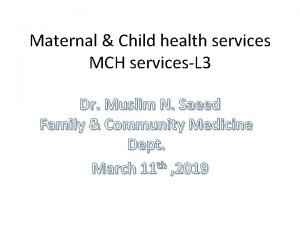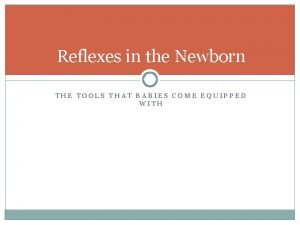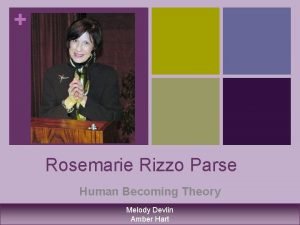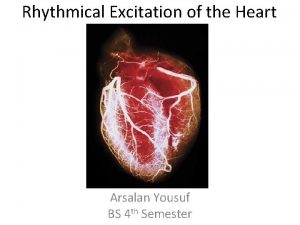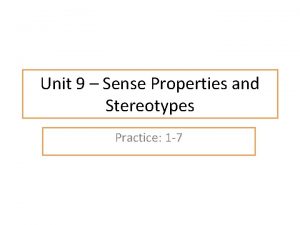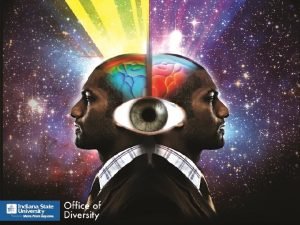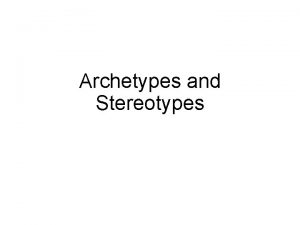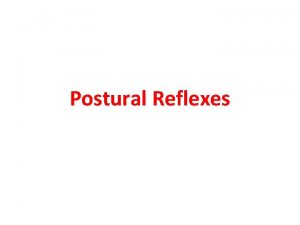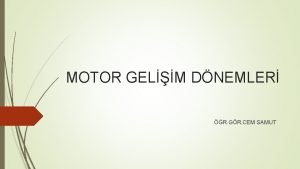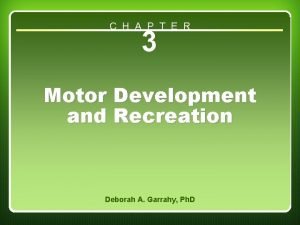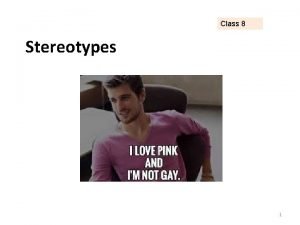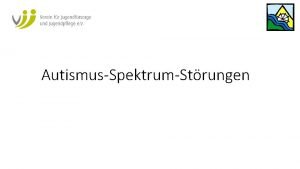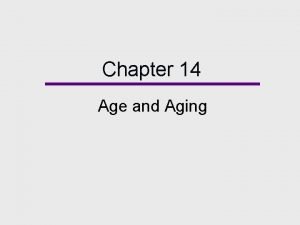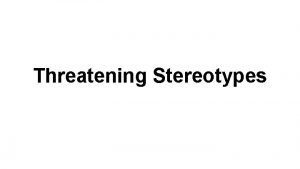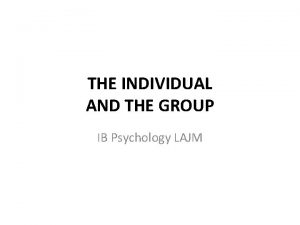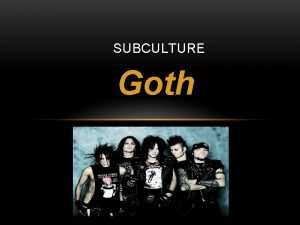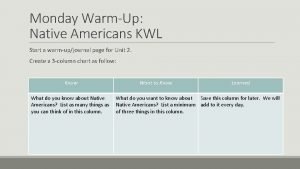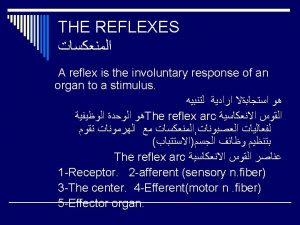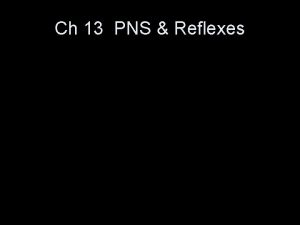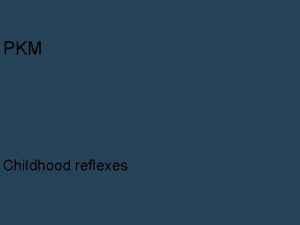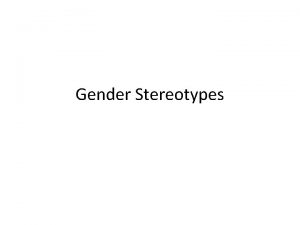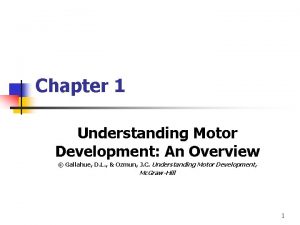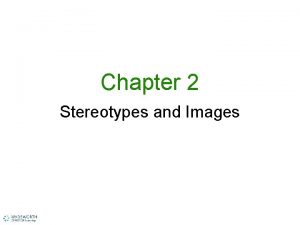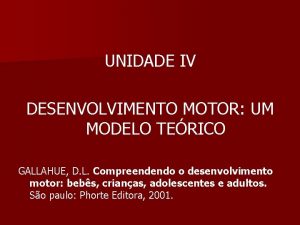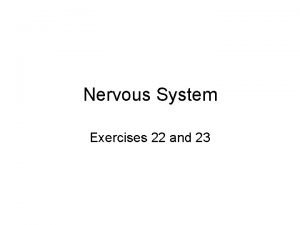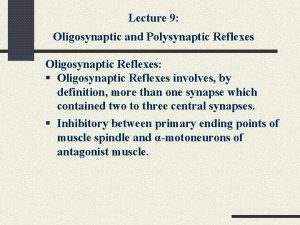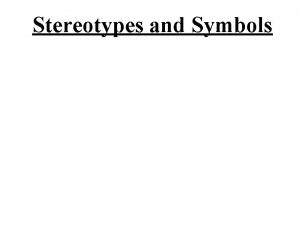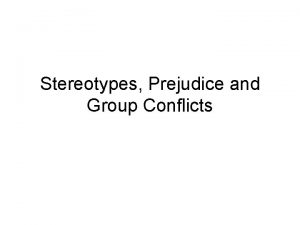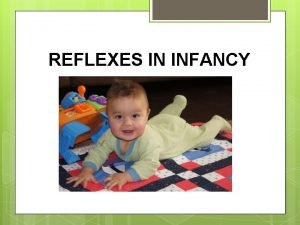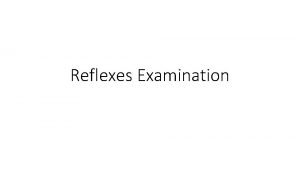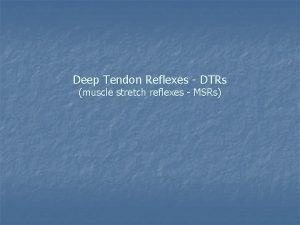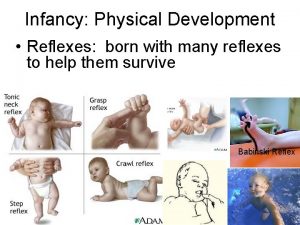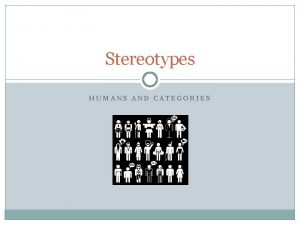Chapter 7 Infant Reflexes and Rhythmical Stereotypes Gallahue































- Slides: 31

Chapter 7 Infant Reflexes and Rhythmical Stereotypes ©Gallahue, D. L. , & Ozmun, J. C. . Understanding Motor Development. Mc. Graw-Hill Live Your Purpose ECH 340 Dr. Kathryn A. Short 1

Key Concept The study of infant reflexes and stereotypical patterns of behavior yields useful information for better understanding the process of motor development. View video, Swartwood & Trotter, Newborn perceptions and sensations Live Your Purpose ECH 340 Dr. Kathryn A. Short 2

Reflexive Movement Phase n Information encoding stage _______________ (4 th fetal month – 1 st perinatal neonatal week – info gathering stage) n Information decoding stage _________________ (4 weeks – 1 year) st n parallels Piaget’s 1 3 stages within the sensorimotor phase of development (reflexes, primary and secondary circular reactions) Live Your Purpose ECH 340 Dr. Kathryn A. Short 3

Reflexive & Self-initiated Movement n The main functions of the primitive survival reflexes are: n n nourishment protection Live Your Purpose ECH 340 Dr. Kathryn A. Short 4

Reflexive & Self-initiated Movement n Two theories about the first forms of movement n Neuromaturational theory (Eckert, 1987) n Dynamic Systems theory (Thelen, 1987) Live Your Purpose ECH 340 Dr. Kathryn A. Short 5

Neuromaturational Theory n As the cortex develops it inhibits some of the functions of the subcortical layers and assumes neuromuscular control n i. e. , the phasing out of reflex behaviors and the assumption of voluntary movement Live Your Purpose ECH 340 Dr. Kathryn A. Short 6

Dynamic Systems Theory n Branch of the ecological theory that views development as discontinuous, self-organizing process composed of several factors –the task, the environment, the individual operate separately and in concert that determine the rate, sequence and extent of development Live Your Purpose ECH 340 Dr. Kathryn A. Short 7

Newborn Reflexes Summary of Reflexes Share The Journey through the Lifespan, DVD 1, Early Infancy Live Your Purpose ECH 340 Dr. Kathryn A. Short 8

Primitive Reflexes (Table 7. 1, p. 127) n n n Search & sucking reflexes (2 parts: expressive & suction phase) Moro & startle reflexes (Figure 7. 1, p. 128) Hand-mouth reflexes (palmer-mental & palmer-mandibular reflexes) Palmer grasp reflex (Figure 7. 2, p. 129) Babinski & plantar grasp reflexes (Figure 7. 3, p. 130) Asymmetrical & symmetrical tonic neck reflexes (Figure 7. 4, p. 130) Live Your Purpose ECH 340 Dr. Kathryn A. Short 9

Newborn Reflexes Rooting, (aka Searching) This reflex is critical for preparation for nursing. Live Your Purpose ECH 340 Dr. Kathryn A. Short 10

Newborn Reflexes Sucking This reflex is basic to our existence. Live Your Purpose ECH 340 Dr. Kathryn A. Short 11

Newborn Reflexes Moro, p. 128 The baby flings out her arms and bringing them back to her chest when startled or feeling in danger of falling. Live Your Purpose ECH 340 Dr. Kathryn A. Short 12

Newborn Reflexes Grasping, p. 129 The grasping reflex is so strong that a four-week -old can support their own body weight for a brief instant. Live Your Purpose ECH 340 Dr. Kathryn A. Short 13

Newborn Reflexes Babinski, p. 130 The infant demonstrates this reflex when the toes fan upward when the bottom of her foot is stroked. Live Your Purpose ECH 340 Dr. Kathryn A. Short 14

Newborn Reflexes Asymmetrical Tonic Neck, p. 130 Most widely researched. Head is turned toward one side. The arms assume a fencer’s position Live Your Purpose ECH 340 Dr. Kathryn A. Short 15

Postural Reflexes (Table 7. 1, p. 127) n n n n Labyrinthine righting reflexes (Figure 7. 5, p. 131) Pull-up reflex (Figure 7. 6, p. 132) Parachute & propping reflexes (Figure 7. 7, p. 133) Neck & body righting reflexes (Figure 7. 8, p. 134) Crawling reflex (Figure 7. 9, p. 134) Primary stepping reflex (Figure 7. 10, p. 135) Swimming reflex Live Your Purpose ECH 340 Dr. Kathryn A. Short 16

Newborn Reflexes Stepping, p. 135 One of the most curious newborn reflexes, this reflex is proof that we were meant to be bipedal. Live Your Purpose ECH 340 Dr. Kathryn A. Short 17

Newborn Reflexes Test your knowledge… A reflex essential for feeding is the ______ reflex. a. Babinski b. grasping c. sucking d. blinking Live Your Purpose ECH 340 Dr. Kathryn A. Short 18

Newborn Reflexes Test your knowledge… Timmy, when startled by a sudden noise or sensing that he is being dropped, flings his arms outward and brings them back to his chest. What is this reflex? a. Moro b. Babinski c. grasping d. stepping Live Your Purpose ECH 340 Dr. Kathryn A. Short 19

Newborn Reflexes Test your knowledge… Sarah reflexively searches for a nipple by turning her cheek towards anything that brushes it and instinctively begins to suck. Which reflex is she demonstrating? a. Babinski b. grasping c. swallowing d. rooting Live Your Purpose ECH 340 Dr. Kathryn A. Short 20

Newborn Reflexes Test your knowledge… Noah appears to be walking, yet he is only 4 weeks old! What reflex is being demonstrated? a. walking b. stepping c. swinging d. Babinski Live Your Purpose ECH 340 Dr. Kathryn A. Short 21

Newborn Reflexes Test your knowledge… What reflex enables Kayla to support her body weight? a. Moro b. Grasping c. Babinski d. Stepping Live Your Purpose ECH 340 Dr. Kathryn A. Short 22

Newborn Reflexes Test your knowledge… In the Babinski reflex, the infant a. turns its head and makes sucking movements when the cheek is stroked. b. grasps an object placed in its hand. c. fans its toes upward when the bottom of the foot is stroked. d. is startled by a loud noise. Live Your Purpose ECH 340 Dr. Kathryn A. Short 23

Diagnosing CNS Disorders n n Preservation of reflexes Complete absence of a reflex Unequal bilateral reflex responses Too strong or weak of a reflex Live Your Purpose ECH 340 Dr. Kathryn A. Short 24

Rhythmical Stereotypies n n n Repetitive rhythmical movements (normal in infants, 4 weeks – 1 yr. ) Rhythmic movements tend to increase just before an infant gains voluntary control, i. e. , rocking prior to creeping) Evidence of self organizing behaviors to control infant motor development Live Your Purpose ECH 340 Dr. Kathryn A. Short 25

Rhythmical Stereotypies n Thelen observed and cataloged 47 stereotypies subdivided into 4 groups: n Legs & feet n Torso n Arms, hands, fingers n Head & face Live Your Purpose ECH 340 Dr. Kathryn A. Short 26

Rhythmical Stereotypies n Legs & feet (kicking, “bicycling”) Earliest stereotypies observed n Movements of legs and feet most common n Live Your Purpose ECH 340 Dr. Kathryn A. Short 27

Rhythmical Stereotypies n Torso prone back arch n rocking from creeping position n sitting rocking n standing bouncing n Live Your Purpose ECH 340 Dr. Kathryn A. Short 28

Rhythmical Stereotypies n Arms, hands, fingers n Live Your Purpose waving, object banging, clapping ECH 340 Dr. Kathryn A. Short 29

Rhythmical Stereotypies n Head & Face (less frequent) n head shaking, tongue sticking, sucking Live Your Purpose ECH 340 Dr. Kathryn A. Short 30

Observation #1: Neurological exams conducted on two infants demonstrating normal and abnormal responses http: //library. med. utah. edu/pedineurologicexam/html/home_exam. html Concluding Concept Infant rhythmical stereotypies provide evidence that human motor development is a self-organizing system that continually strives for increased motor control. Live Your Purpose ECH 340 Dr. Kathryn A. Short 31
 Infant reflexes chart
Infant reflexes chart Juliette is experiencing lifelong
Juliette is experiencing lifelong Infant reflexes chart
Infant reflexes chart Newborn reflexes
Newborn reflexes Human becoming theory symbol
Human becoming theory symbol Rhythmical excitation of the heart
Rhythmical excitation of the heart The rhythmical pattern of a poem
The rhythmical pattern of a poem Infant child and adolescent berk 8th edition chapter 1
Infant child and adolescent berk 8th edition chapter 1 The stereotype of the predicate family
The stereotype of the predicate family Module 2 - stereotypes & biases
Module 2 - stereotypes & biases Archetypes and stereotypes
Archetypes and stereotypes Air righting reflex
Air righting reflex Difference between conditioned and unconditioned reflex
Difference between conditioned and unconditioned reflex Pregnancy and infant cohort monitoring and evaluation
Pregnancy and infant cohort monitoring and evaluation Gallahue piramit modeli
Gallahue piramit modeli Gallahue piramit
Gallahue piramit Gallahue's hourglass model of motor development
Gallahue's hourglass model of motor development Slovenia stereotype
Slovenia stereotype Explain the 5 principles of panchatantra.
Explain the 5 principles of panchatantra. Language stereotypes
Language stereotypes Stereotypes spielverhalten
Stereotypes spielverhalten 12 angry men stereotypes
12 angry men stereotypes Hero stereotypes
Hero stereotypes Age stereotypes
Age stereotypes Czech stereotypes
Czech stereotypes Essential questions about stereotypes
Essential questions about stereotypes Activity 1 what do you know about stereotypes
Activity 1 what do you know about stereotypes Hamilton and gifford 1976 ib psychology
Hamilton and gifford 1976 ib psychology Stereotypes of goths
Stereotypes of goths Bias
Bias Kwl chart stereotypes
Kwl chart stereotypes Seterotype
Seterotype
